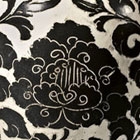J.J. Lally & Co., Oriental Art / New York City, New York
MenuPast Exhibition
Chinese Ceramics in Black and White
March 20–April 10, 2010
31.
A CARVED CIZHOU ‘BLACK- AND WHITE’-GLAZED
STONEWARE MEIPING
Northern Song Dynasty (A.D. 960–1127)
the high-shouldered ovoid bottle-vase decorated in sgraffiato technique with three large full-blown peony blooms borne on undulating leafy stems which rise between the flowerheads and terminate in trefoil leaves, all boldly carved through the very dark brown-black glaze to the creamy-white slip below, filling a wide central frieze which is framed by matching bands of overlapping petal motifs delineated by sinuous white lines incised through the dark brown-black glaze around the tapering foot and encircling the wide shoulders below the short narrow neck with flat, flaring dished rim, covered all over with a transparent glaze, the recessed base with splashed brown and white slip, the sturdy ring foot unglazed revealing the silvery-gray stoneware body.
Height 129⁄16 inches (32 cm)
This type of black-and-white carved sgraffiato ware, widely regarded as the most complex and impressive of all Cizhou wares, was produced in the famous northern Chinese kilns at Guantai, in Ci county, Hebei province. Shards of vessels showing decoration very similar to the décor on the present vase are illustrated in the report on the excavation of the Guantai kiln site, Guantai Cizhou yaozhi (The Cizhou Kiln Site at Guantai), Beijing, 1997, pl. 25–4 and col. pl. 21–2.
Cizhou meiping of this form and design are in several important museum collections. A closely related example in the Metropolitan Museum of Art, New York, is illustrated by Valenstein in A Handbook of Chinese Ceramics, New York, 1989, p. 93, no. 88. The same vase was previously illustrated by Wirgin in “Sung Ceramic Designs,” B.M.F.E.A., Bulletin no. 42, Stockholm, 1970, pl. 49-b. Another similar example in the John D. Rockefeller 3rd Collection is illustrated by Leidy in Treasures of Asian Art: The Asia Society’s Mr. and Mrs. John D. Rockefeller 3rd Collection, New York, 1994, p. 161, no. 153. Other examples are in the British Museum, from the Collection of Mrs. Walter Sedgwick, illustrated by Barret et. al. in The World’s Great Collections: Oriental Ceramics, Vol. 5, The British Museum, Tokyo, 1981, fig.110; in the Worcester Art Museum, from the Osgood Collection, illustrated by Mino in Freedom of Brush and Clay Through Seven Centuries in Northern China: Tz’u-chou Type Wares, 960–1600 A.D., Indianapolis, 1980, pl. 39, p. 103, where the author also illustrates another similar meiping in the collection of the former royal house of Yi in Seoul, op. cit., fig 99, p.102; and another meiping of this type, in the Ise Cultural Foundation, Tokyo, is illustrated in Charm of Black & White Ware: Transition of Cizhou Type Wares, Osaka, 2002, pl. 52, p. 85.
北宋 磁州白地黑釉刻花梅瓶 高 32 厘米
